‘We disobeyed the canons of the 1970s that wanted Val di Fiemme to be a strictly tourist location and our parents refused to tear down the old family pasta factory to build residences and holiday homes.’ From the stage of the Sala Blu, Riccardo Felicetti, general manager of the pasta factory bearing the same name, recounts his relationship with the theme of Identità Milano 2024: ‘We fourth-generation cousins worked hard to do a more difficult and innovative job by searching for Italian grains when even their producers were unaware of their value. Working with organic products, we teamed up with farmers and put technology at the service of a raw material that must necessarily be the basis of everything.’ This is the tale of disobedience that opens the day dedicated to the most famous Italian product in the world: Identità di pasta, 15th edition, introduced by Niccolò Vecchia and hosted by Eleonora Cozzella.
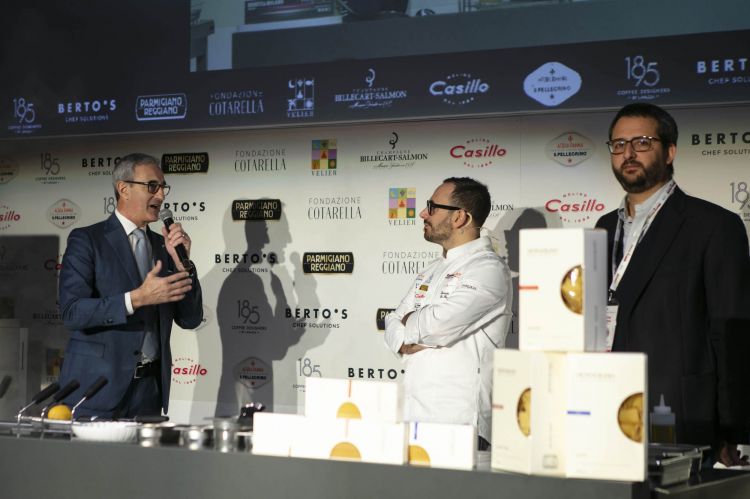
Riccardo Felicetti, Davide Di Fabio and Niccolò Vecchia
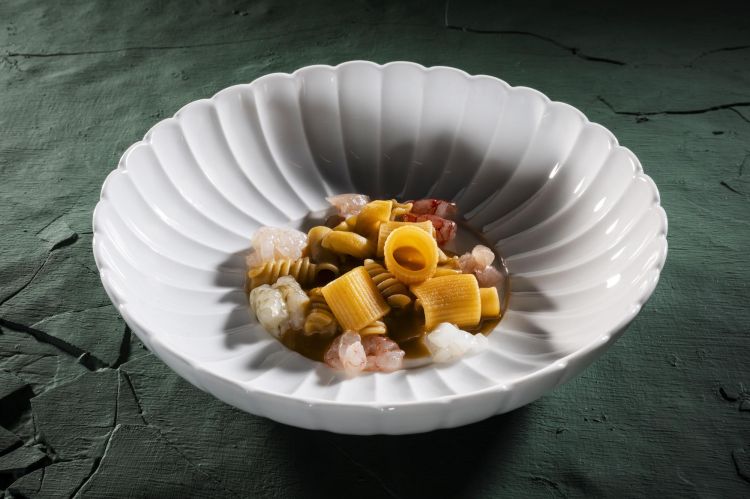
Davide Di Fabio’s Virtù Teramane
‘
Le virtù is a historical recipe prepared in the Teramo area on the first of May.’ The disobedience of
Davide Di Fabio, chef and owner of restaurant
Dalla Gioconda in Gabicce Monte, starts from memory. ‘According to inland tradition, we should use seven types of pasta, seven types of fresh pulses, seven types of meat. While on the coast, the recovery dish par excellence is
brodetto made with all the fish that were not sold.’
Di Fabio cooks the pasta first in water and salt, then in a filtered and reduced brodetto made with small fish (small rockfish, weever, small rays) and a crustacean. ‘We then stir in a cream of legumes, olive oil and lemon peel.’ At the base of the dish, the chef arranges 7 types of raw fish, in this case mullet, pink shrimp, humpback, amberjack, langoustine, cuttlefish, shrimp, which will give different sensations when chewed and when the temperature changes, and adds a series of sauces recalling the ingredients of brodetto: sweet garlic, parsley, tomato: ‘Finally I finish with a mix of colours: mussel, clam, mantis shrimp, squid ink.’ Other technical virtuosities, variations on the pasta theme, performed by
Davide Di Fabio on stage were
Paccheri alla suzette,
Spaghettone scotto with sour cream, mace, lemon and parmesan cheese,
Cappelletti with bitter olives with orange butter and sea urchins,
Tagliolini with caviar, porcini and mugo pine, and
Ravioli with custard and salt, cinnamon and rosolio.

Vladimiro Poma and Cesare Battisti
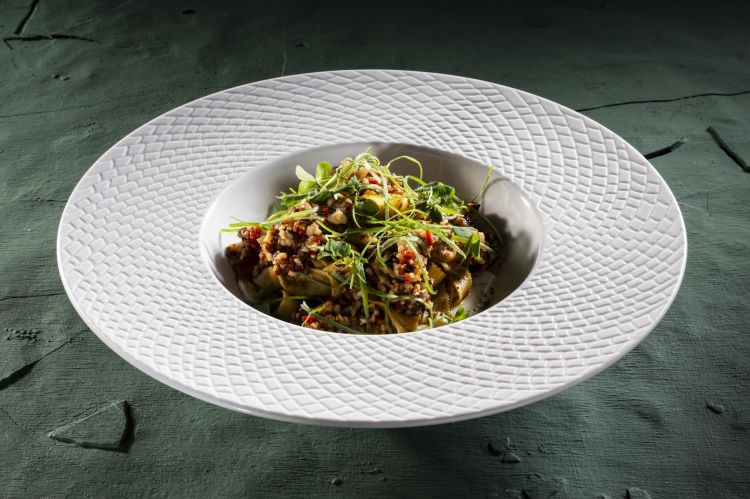
Battisti/Poma's pasta salad
‘Disobedience in the kitchen has always been there, otherwise we would be eating things today that we ate a hundred years ago.’
Cesare Battisti, chef and owner of restaurant
Ratanà and
Silvano - Vini e cibi al banco in Milan, on stage with his right-hand man Vladimiro Poma, does not shy away from the rebellious theme, indeed he raises the bar: ‘Mixed pasta is always made in broth, instead we want to give the guest the fun of eating it as a dry pasta.’ It is cooked in a beetroot centrifuge, at the base of the dish a puree of cannellini beans cooked with a garlic clove, a bay leaf and celery heart; to finish, smoked pike roe and horseradish.
The second dish presented by the Battisti-Poma duo is another revolution.
Poma explains: ‘Pasta salad is eaten all over the world, especially in Asia, and we realised that the fil rouge of these recipes were acidic, savoury, sweet and spicy notes. So we wanted to create a dish with this logic but with Mediterranean ingredients.’ A fresh pasta salad: noodles cooked normally in water then cooled in water and ice, seasoned with tomato water molasses reduced with honey and a little lemon juice and a final ingredient: ‘A sort of
ajoblanco of which we were only interested in the fatty, spicy, perfumed part to make the pact harmonious.’ The dish is thus composed of a cream of almonds and garlic, cold tagliatelle noodles seasoned with tomato molasses and chopped ginger, spring onion and chilli.
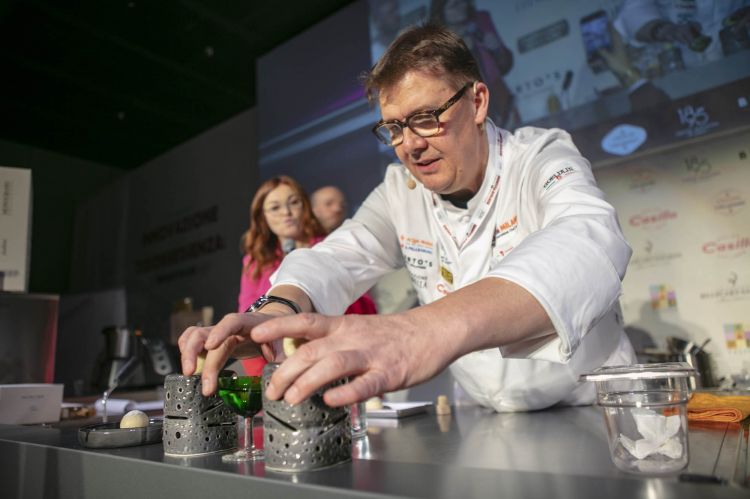
Alessandro Gilmozzi and Eleonora Cozzella, who’s been hosting Identità di Pasta since the first edition
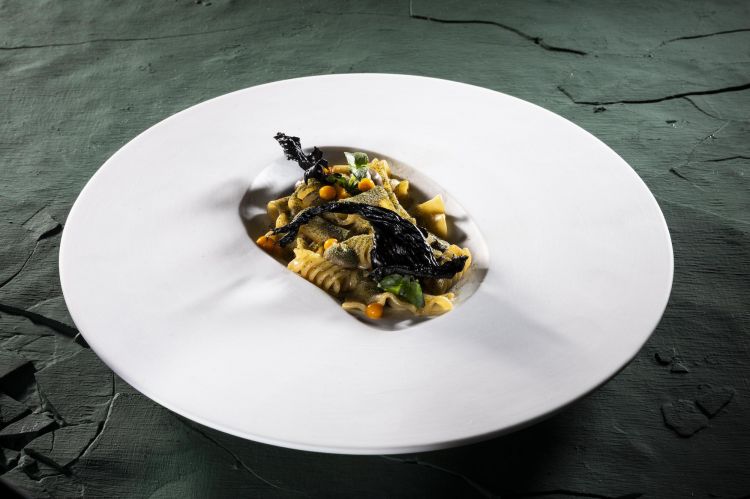
Alessandro Gilmozzi’s mixed pasta
The president of the
Ambasciatori del Gusto association,
Alessandro Gilmozzi is chef and owner of restaurant
El Molin in Cavalese. From the stage with his sous-chef
Antonino Margagliotta, he presents a double disobedience: a
Mochi that cheats two traditions, Italian and Japanese, as it is made of pasta and not glutinous rice. ‘We worked on starch,’ the chef born in 1965 explains, ‘by overcooking the pasta and blending it. Once cooled, we brought it back to 100°C to make it almost like collagen.’ We then flavoured the dough with a whipped mixture of water and pine nuts and added some marzipan. The dough is placed in moulds with apricot jam and covered with more dough. After chilling it for a few minutes, the sphere is shaped with the hands and served.
Chef Gilmozzi's second recipe is
Pasta mista with mushrooms, sea buckthorn, mountain verbena and fried horn of plenty: 'We’ll use a mixed pasta of six different shapes of
Matt wheat, tenacious and very fragrant, from Apulia, which we’ll cook in a mushroom broth and combine with mountain products. The mushrooms are morchelle, chanterelles, horn of plenty, porcini; the broth is thickened in an
ocoo pot for four hours in extraction then filtered. Sea buckthorn, passed through nitrogen, squeezed in an extractor, and mixed with oil and xanthan, becomes a caviar and will give a sour note. The dish is finished with rehydrated and fried horn of plenty.
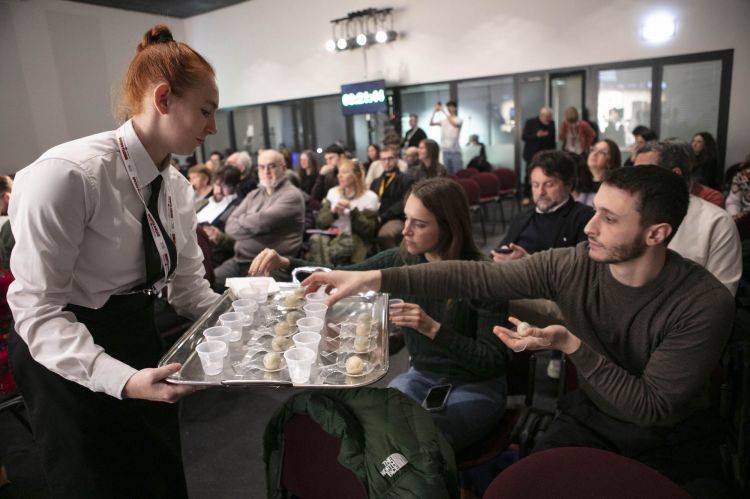
The tastings are always highly appreciated in the blue rooms
Translated into English by Slawka G. Scarso